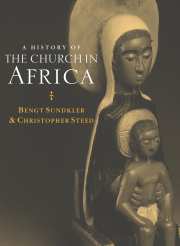Book contents
- Frontmatter
- Contents
- List of maps
- Acknowledgements
- List of abbreviations
- Introduction
- PART I THE FIRST FOURTEEN HUNDRED YEARS
- PART II THE MIDDLE AGES 1415 – 1787
- PART III THE LONG NINETEENTH CENTURY 1787 – 1919
- PART IV THE COLONIAL EXPERIENCE 1920 – 1959
- PART V INDEPENDENT AFRICA 1960 – 92
- 18 Introduction to Independent Africa
- 19 North and North-Eastern Africa
- 20 West Africa
- 21 Central Africa
- 22 Southern Africa
- 23 East Africa
- 24 Ecumenical Perspectives
- 25 Epilogue
- Notes
- Bibliography
- Name index
- Subject index
24 - Ecumenical Perspectives
from PART V - INDEPENDENT AFRICA 1960 – 92
Published online by Cambridge University Press: 16 September 2009
- Frontmatter
- Contents
- List of maps
- Acknowledgements
- List of abbreviations
- Introduction
- PART I THE FIRST FOURTEEN HUNDRED YEARS
- PART II THE MIDDLE AGES 1415 – 1787
- PART III THE LONG NINETEENTH CENTURY 1787 – 1919
- PART IV THE COLONIAL EXPERIENCE 1920 – 1959
- PART V INDEPENDENT AFRICA 1960 – 92
- 18 Introduction to Independent Africa
- 19 North and North-Eastern Africa
- 20 West Africa
- 21 Central Africa
- 22 Southern Africa
- 23 East Africa
- 24 Ecumenical Perspectives
- 25 Epilogue
- Notes
- Bibliography
- Name index
- Subject index
Summary
THE CATHOLICS AND VATICAN II
The Popes and Africa
The strength of the Roman Catholic Church had always been its solid foundations, its tradition, language, law and liturgy. Then the good Pope Johannes XXIII called the Church to an aggiornamento, and the Church was hit by the greatest spiritual change and challenge, yes, revolution, of the latter part of the twentieth century: Vatican II. To a degree which cannot be fathomed, at least not by a Protestant observer, the local dioceses of the Church in Africa, under African bishops, realized that they were now placed in a completely new situation, standing at the door to the future.
Pope Pius XII showed the way. His role cannot be referred to without mentioning his initiative in 1957, the encyclical Fidei Donum. In his Easter message of 1957 the Pope suggested that bishops in the ‘First World’ send some of their priests to Africa for a certain period. In fact these priests worked on average nine years in Africa, their average age being around fifty years old. In 1982 the following numbers were involved in the Fidei Donum programme: in North Africa thirty-seven, in Black Africa 124, and on Madagascar fourteen, devoted to the following tasks: pastoral service; Catholic Action; schools; and theological seminaries with catechetical training. Examples are known of priests who have served for over thirty years in this capacity, far beyond the retirement age.
- Type
- Chapter
- Information
- A History of the Church in Africa , pp. 1018 - 1037Publisher: Cambridge University PressPrint publication year: 2000



